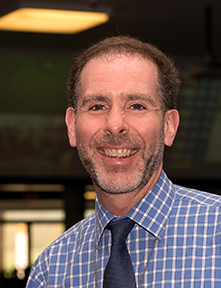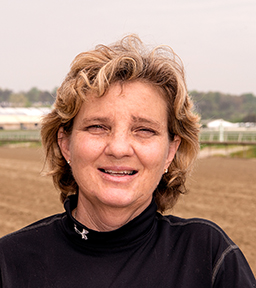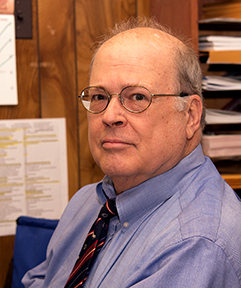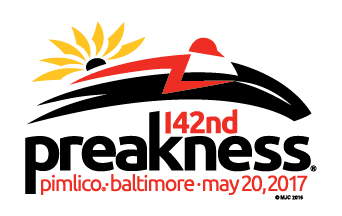 by Katherine O. Rizzo with photos by Jim McCue
by Katherine O. Rizzo with photos by Jim McCue
(first appeared in the May 2017 print edition of The Equiery; #Preakness2017)
With well over 100,000 people converging on Pimlico Race Course in Baltimore for one important race day in May and billions watching around the world, the Preakness Stakes is very much in the spotlight. The pressure is high to put on a good show and the race goes off each year without a hitch only because of the people behind the Preakness. These men and women hold all kinds of jobs from general manager to track farrier to pony riders and each and every one of them makes the second jewel in the Triple Crown the people’s party, the race that horsemen and spectators alike often say is just plain done right.
Each year, we chat with a few of the Preakness people, about their roles, memories and more. (Click here for Preakness people from prior years).

Assistant General Manager Tim Luzius
Although Tim Luzius has only recently been named Assistant General Manager for the Maryland Jockey Club, he has been a member of the MJC family for 30 years. Tim got his start at the racetrack as a mutuel teller in 1988 when he and his brother answered an ad in the paper while looking for part-time work. “I started by just working some of the bigger races at Pimlico, Laurel and nights at Freestate, the harness track,” Tim explained. “When I was attending UMBC, the hours worked well with going to school and the pay allowed me to not have to take out a student loan.”
Tim went on to earn his masters degree and an MBA from the University of Baltimore while continuing to work as a mutuel teller. By this point, Freestate had closed and Tim moved over to Rosecroft. “I started picking up more responsibilities like training the new people and counting pouches in the money room,” he stated. Eventually he moved on to being a full-time supervisor and then floor manager. In 2007, Tim was promoted to director of pari-mutuels. “I was also the simulcast director at some point,” he added.
In September of 2016, MJC Vice President and General Manager Sal Sinatra, along with Tim Ritvo, COO of Racing for the Stronach Group, asked Tim to take over as assistant general manager.
When asked what his most memorable Preakness was over the last 30 years, Tim could not just pick one. “There are so many to choose from!” he said. “Barbaro was an unfortunate scene but was handled well, Real Quiet was another great horse… even last year with Exaggerator was incredible to watch.”
And with this year’s Preakness Stakes just around the corner, Tim advises Pimlico newbies to head to the paddock on race day. “Go take a look at the horses before each race. See how the horses are feeling, watch them head to the track, exercise and get into the gate,” he recommends. “Get a real feel for the horses. It is such a great experience to be able to get that close and take it all in.”
 Stall Manager Terry Overmier
Stall Manager Terry Overmier
Before Terry Overmier took over for stall manager Charlie Hall when he retired a few years ago, Terry was a groom for various trainers for several years as well as a mutuel teller for MJC. She had been working with Charlie assigning stalls for the receiving barn and officialy moved into the position about a year and a half ago.
“I am the one who is in charge of assigning the stalls for each barn, counting the number of horses on the grounds,” she stated. “I basically need to know where everyone is at all times and make sure the horsemen all follow the rules. The job really has a lot of things involved with it.” Terry added that at times she even feels like “Dear Abby” as she often answers tons of questions and helps keep everyone getting along with each other.
Terry manages the barns at both Laurel and Pimlico but says things really start to heat up at Pimlico as soon as the Kentucky Derby is over. “I make sure the stalls are ready for each horse to arrive and meet them at the van,” she said. “Most of the Preakenss horses will arrive the week before the race but some of the more local horses will ship in at the last minute.” Terry explained that Preakness horses must be on the Pimlico grounds no later than 7 a.m. Preakness morning. “Most will want to be here early, though.” She also pointed out that not all horses running in the Preakness Stakes will stay in the stakes barn. “Some trainers don’t want to be in the stakes barn because they don’t like all the commotion of press and such.”
Once the horses are all settled in, Terry also makes sure everything runs on time. “You can’t be late for the Preakness!” she said, laughing. “The whole atmosphere of Pimlico is exciting during Preakness. I love them all. The Preakness horses are just big and beautiful and not your average race horse.”
 Lasix Clerk Melanie Martin
Lasix Clerk Melanie Martin
Melanie Martin has been working for the Maryland Racing Commission for four years as the Lasix Clerk. Before then, she worked in the test barn collecting samples for eight years. Her husband Dennis was a trainer and they also raced a few horses of their own. Martin worked at GBMC for 25 years but took time off while being treated for breast cancer. “I just got tired of that sort of work and wanted to do something I love,” she said. “I love being around the horses.”
The Lasix Clerk position is a fairly new job with Martin being the first one. “Lasix is the only medication that horses are allowed to be given on race day,” she said explaining, “It helps prevent bleeding into the horses’ lungs.”
Each day Martin looks through the overnights for the next race day to see which trainers have declared their horses will be using Lasix. She then goes to each trainer and asks how much the horse will be given and then records all this information for the track veterinarians. “Typically 99% of the horses are using Lasix these days,” she said. “Between two and 10ccs are allowed but most will use about four or five.”
Martin went on to explain that most trainers do tend to run their two-year-olds without Lasix to see how they do and will then switch onto it later. “A trainer can’t just give their horse Lasix, however,” she added, “They have to have the vet look at the horse, often doing a scope, and sign off that the horse needs it. And then if the horse goes off of it for any reason, another exam is required before starting back up on it.”
During Preakness week, Martin also works in hospitality assisting Pheobe Hayes. “Preakness week is awesome! Everyone loves Pimlico and things get really ramped up for the Preakness,” she stated. In the Stakes Barn, Martin’s primary job is to take care of the horsemen, helping them get around, order supplies, and the like. “We set up a breakfast every day and on Thursday we take the grooms out for dinner,” she said. “They are often stuck with the horses all day so it is nice to do something just for them!” There is a crab feast on Friday and then a post-Preakness cocktail party after the big race.
On Preakness morning, Martin hands out bibs, jackets, hats and other logo wear to those with Preakness horses. “The horsemen are very appreciative of what we all do for them. They often tell others that Maryland does it right!” she added.
 On-Air Racing Analyst Stan Salter
On-Air Racing Analyst Stan Salter
Today, Stan Salter is best known for his own Maryland Horse Racing radio show, but during Preakness, he is the On-Air Racing Analyst giving reports all week on both radio and television shows. Stan grew up in the sport right here in Maryland as his father was a racehorse trainer and his mother a show rider and barn manager. “I grew up on a few different farms here in Maryland and showed a lot in the hunter ring as a teenager,” he said. At 16 years old, Stan won the Junior Medal Finals for the Howard County Horse Shows Association.
While as a teen, he also started galloping horses for his father. He rode back on the woods track at the Bowie Training Center when he was 14 and then at 16, got his license. He showed in the Intercollegiate Horse Show Association for Towson University while still being involved with the Maryland racing industry.
In the spring of 1998, Stan took his first radio classes and covered his first Preakness for a local Towson station. The following year he got an internship with WMSG of Baltimore, which lasted until 2004. Stan’s radio career began to blossom as he moved around to different stations and in the early 2000s he hosted a weekly show that featured breeding and racing farms. All the while, he was still galloping racehorses for trainers like Jonathan Shepard and Nick Zito.
In December of 2004, Maryland Horse Radio was born. Stan officially began working for the Maryland Jockey Club in 2008 as a racing official and then, in 2015, started broadcasting a morning television show. Stan describes Preakness mode as a “real fast pace with everyone rising up to the occasion,” adding, “It takes a lot of preparation to put on the Preakness and lots of pride to produce such a great race meet.” Stan went on to say, “Hosting the Preakness is like having a Super Bowl in your backyard each year.”
On Preakness Day, Stan arrives at Pimlico by 4 a.m. “and even then I feel like I’m running late!” The first broadcast from the Stakes Barn begins at 6 a.m. and runs until 9 a.m. “The whole show is live with us talking with trainers and owners and racing officials. Live interviews are always better,” he explained. Right after the morning show, the simulcasting show begins by going on the air by 9:30 a.m. with the first race typically having a 10:45 a.m. post time. From there, Stan is on television all day reporting on each race. After the Preakness concludes, there is a party at the Stakes Barn, meaning Preakness becomes close to, if not more than, a 24-hour work day.
But it is certainly worth it as Stan has many Preakness memories to share. “Real Quiet winning in 1998 will always stand out for me since it was my first time covering the Preakness. Then there was when Afleet Alex almost fell in 2005 but still won. It was my first time covering the Preakness on my own radio show,” he remarked. Big Brown and Rachel Alexandra were mentioned as well as I’ll Have Another. “Doug O’Neil is always great to cover. He’s great with the media,” Stan said.
“And then there is American Pharoah!” he exclaimed. “I was in the infield when the skies opened up. That was an epic rain storm! And what an impressive performance that horse gave.”
 Stakes Coordinator Coleman Blind
Stakes Coordinator Coleman Blind
Coleman Blind has been the Stakes Coordinator for the Maryland Racing Commission for the past nine years but grew up in the industry and has worked for the racing office since 1970 in a variety of positions. He galloped horses at Timonium and worked the in-gate with his father Eddie, who was the official starter for 35 years. His uncle Eric was a jockey who rode in the Kentucky Derby and Preakness Stakes and his brother Frank was also a starter for a while before becoming a golf pro. In addition to working at tracks outside of Maryland, Blind was a National Steeplechase Association steward for many years at races up and down the East Coast.
But after working 47 Preakness Stakes, there is only one that Blind considers the most memorable, “Secretariat. I was a patrol judge at the quarter pole. Just an awesome horse.” Oh, and he also has a photo from 1948 of him and his father and trainer “Uncle Jimmy” Jones of Calumet Farm standing with Triple Crown winner Citation. “Sunday Silence, Easy Goer and I’ll Have Another were all great winners as well,” he added.
As the Stakes Coordinator, Blind is the one who speaks with trainers and owners to invite them to run horses at Pimlico and Laurel in their stakes races. “Basically I try to sell our races to get people to come,” he explained. Then on entry day, he will follow up with the connections of the various horses who are nominated to fill the race card. “Things are a little bit different for the Preakness,” he said, explaining that there are early, late and supplemental nominations. In addition, the winner of the April 22 Federico Tesio Stakes at Laurel gets an automatic spot in the Preakness and the winner of the Weber City Miss Stakes, also at Laurel, gets into the Black-Eyed Susan Stakes.
Blind will be at the Kentucky Derby and will talk with trainers after the race to secure entries into the Preakness and help make arrangements to get these horses to Pimlico. “Sometimes this can be difficult as there are only two weeks between the two races,” he stated. “The winner always comes if he is fit enough. A lot of this job is communication and building relationships with horsemen across the country.”
Although the Preakness Stakes is clearly the crown jewel of Preakness weekend, there are in total 15 stakes races on the Friday and Saturday of Preakness week. “My job is to get the best of the best to come and race on those two days,” Blind said, adding that he has a staff of three who help make sure that each race is full. “What is really cool about the Preakness is that a lot of Eclipse winners or nominated horses have run in it and then gone on to do more things. It is a nice feeling to see these horses continue to run well.”











